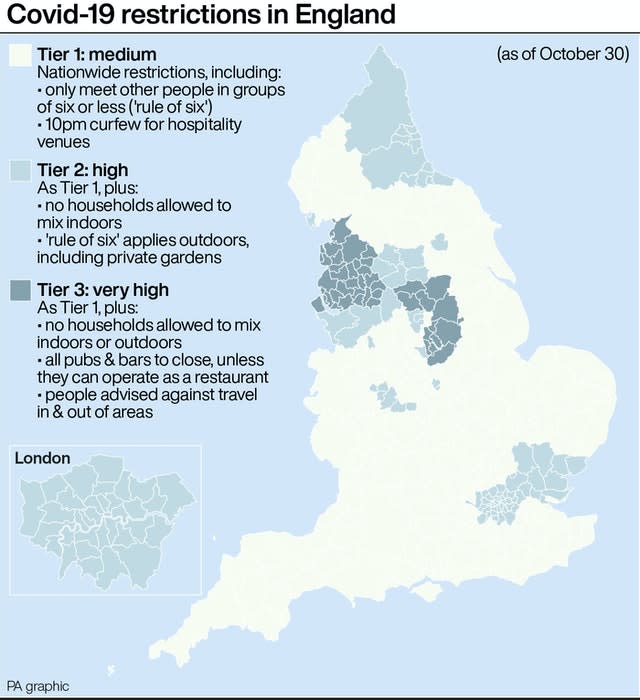England’s coronavirus restrictions ‘not sufficient’ as infections soar
Coronavirus restrictions in England are “not sufficient” with infections doubling approximately every nine days, experts have warned.
As France enters a second lockdown from Friday and Germany imposes a four-week partial lockdown, the second wave of Covid-19 is said to have reached a “critical stage” in England, but the Government continues to resist more stringent measures.
Interim data from round six of the Imperial College London React study estimates there are around 96,000 new infections per day, and found early signs that numbers in low-risk areas are following trends observed in the worst-affected regions.
Communities Secretary Robert Jenrick said coronavirus rates are in a “bad place” all over the country but added that the Government is resisting another national lockdown.
He told Sky News: “We will continue with our localised but proportionate approach on taking action where the virus is strongest, but you can see from those figures that the virus is in a bad place in all parts of the country.
“The approach of trying to bear down on it where it is most concentrated, I think, continues to be the best way forward because despite the fact the virus is rising across the country it is very concentrated in some places nonetheless.”
Mr Jenrick said the Government’s “very firm view” is that a short national “circuit-breaker” lockdown would be the wrong approach, saying “you can’t have a stop-start country”.

But Steven Riley, professor of infectious disease dynamics at Imperial College London, said the data from the React study suggests “we need to think about changing the approach”.
Asked if this meant tightening local lockdowns or national restrictions, he told BBC Radio 4’s Today programme: “I think what our study shows is there would be genuine benefits to some kind of national policy.
“In that we could prevent the pattern in the South turning into the current pattern in the North and bring about a reversal in the North as quickly as possible.
“If we’re going to end up using those restrictions that have been brought in elsewhere in Europe today and yesterday… we should think about timing. And sooner is better than later for these.
“There has to be a change. The rate of growth that we’re seeing in these data is really quite rapid, so one way or another there has to be a change before Christmas.
“We’ve fairly reliably measured a slight decrease in R (reproduction number) in our interim round five, now we have measured a slight increase in R, and the slight increase in R means that current measures are not sufficient.”
Government scientific adviser Dr Mike Tildesley has said more national restrictions are needed, with the current trajectory likely to put nearly everywhere in Tier 2 before Christmas.
The University of Warwick researcher, who sits on the Scientific Pandemic Influenza Group on Modelling (Spi-M), told BBC Radio 4’s Today programme: “We are seeing the R number is greater than 1 everywhere, and in a sense some kind of national lockdown, a circuit-breaker, or something along those lines, would actually have more effect in those parts of the country that have not yet progressed into Tier 2.
“R is greater than 1 everywhere and if we don’t take urgent action we’re most likely to see that as we’re approaching the festive period we’re probably going to be at least in Tier 2 pretty much everywhere in the country.
“So really we need to move away from these regional firefighting techniques to try to move to something more national.”
Dr David Strain, clinical senior lecturer and honorary consultant at University of Exeter Medical School, questioned the rule of six.
“The rule of six is fundamentally flawed – it allows people to spread the virus around multiple households completely legitimately.
“Yet this is permitted indoors in Tier 1 and outdoors in Tier 2. All of these mean the virus is still growing.”

Dr Strain said a national lockdown or circuit-breaker can only be effective if there is a “sensible exit strategy”, adding: “I do believe the local approach is likely to be a better way forward. Currently the focus is very much on controlling the outbreaks in Tier 3.
“More focus should be placed on maintaining Tier 1 regions in Tier 1. These areas, after all, are currently maintaining the economy.”
Meanwhile, the Government is reportedly considering the rapid unrolling of saliva-based coronavirus kits in a bid to test up to 10% of England’s population every week.
According to the Guardian, NHS Test and Trace is stepping up its efforts to meet the targets set out in the Government’s Operation Moonshot plans announced last month.
The testing programme would focus on regions under the highest level of restrictions, and would mark a significant increase on current capacity of 2.1 million conventional nose and throat swabs a week.
The leaked letter comes as the latest Test and Trace figures are due to be released on Thursday, a source of criticism for the Government in recent weeks.
Last week’s figures revealed just 59.6% of the proportion of close contacts of people who tested positive were reached – the lowest weekly percentage since the programme began.
In Scotland, First Minister Nicola Sturgeon is preparing to reveal how a new five-tier system of restrictions will apply across the country.
Decisions on which levels will apply to each region will be announced on Thursday.

 Yahoo Finance
Yahoo Finance 